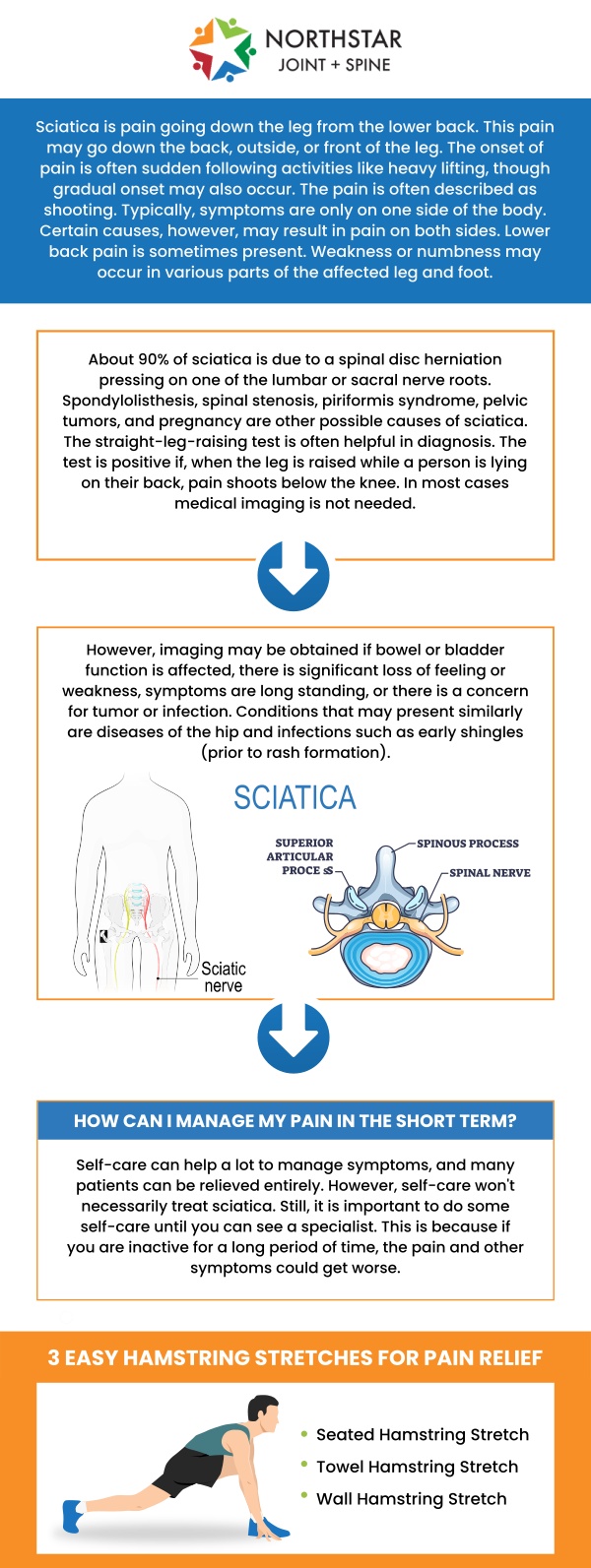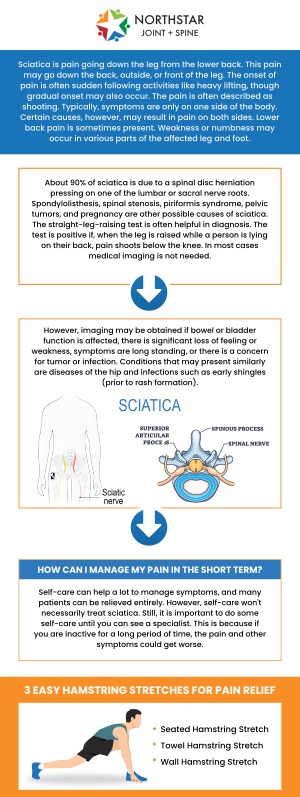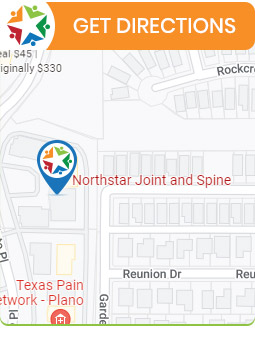How Does Sciatica Pain Feel?
Sciatica pain results from irritation or compression of the sciatic nerve, causing sharp, burning pain that travels from the lower back down the leg. It often feels like shooting pain, numbness, or tingling along the nerve’s path. At Northstar Joint and Spine, Board Certified Dr. Robert J. Nocerini, MD, offers comprehensive care to accurately diagnose and effectively treat sciatica. For more information contact us today or schedule an appointment online. We are conveniently located at 7704 San Jacinto Pl Suite #200 Plano, TX 75024.


Table of Contents:
How long does sciatica pain typically last?
What does sciatica feel like in the lower back?
Can sciatica cause a burning or tingling sensation?
Does sciatica pain get worse when sitting or standing for long periods?
How Does Sciatica Pain Feel and When Should You See Dr. Robert J. Nocerini, MD in Plano, TX?
How long sciatica pain lasts depends on what’s causing the pressure along the nerve in the first place. For some, the pain fades within a few weeks once swelling or tightness in the area is reduced. In other cases, especially when the underlying issue isn’t addressed, the discomfort can linger or return in cycles. It’s common for the pain to feel like it’s improving, only to flare up again with certain movements or after long periods of sitting or walking. There’s no set timeline that applies to everyone, and the symptoms can shift from day to day depending on posture, activity, and how much pressure the nerve is under. If the discomfort stays consistent for longer than expected, or if the individual notices other symptoms like numbness or muscle weakness, that’s often a sign the problem is more than temporary. In those cases, the specialists at Northstar Joint and Spine may recommend a closer evaluation to understand what’s keeping the nerve inflamed.
When sciatica begins in the lower back, it tends to carry a specific kind of discomfort that’s different from general soreness or muscle fatigue. Some describe it as a sharp jolt or electric pulse that flares up suddenly, while others feel it as a dull ache that stays low in the spine and doesn’t seem to shift with position. It’s not always constant, instead, it can spike with movement, especially when bending, twisting, or trying to rise from a seated position. The sensation often starts deep in the lower spine before it travels down the back of the leg, which is what separates it from typical back pain. That shooting or radiating feeling is usually what makes sciatica easier to pinpoint. Even when the pain in the leg is more intense, the source is often rooted in a compressed or irritated nerve near the lower back. When that area stays inflamed, the discomfort can spread quickly, especially with repetitive movements or prolonged sitting.
Sciatica can lead to a burning or tingling feeling along the path of the nerve, and that sensation can vary from subtle to overwhelming depending on how compressed the nerve becomes. Some individuals describe it as pins and needles running down the back of the thigh or into the calf, while others say it feels like the skin is overheated or hypersensitive. That nerve-based discomfort can come and go, or settle into a pattern where certain positions trigger it more often than others.
These sensory changes are often the body’s way of signaling that the nerve is being irritated. When the tingling or burning becomes a regular part of the day, it usually means the inflammation hasn’t resolved and is affecting how the nerve communicates with the rest of the body. While those sensations don’t always come with sharp pain, they can still disrupt normal movement or limit how long someone can sit, walk, or even lie down comfortably.
Sciatica often becomes more noticeable during long stretches of sitting or standing, especially if the body remains in one position without much movement. Sitting for too long can put direct pressure on the base of the spine and the surrounding muscles, which may already be pressing against the sciatic nerve. That added strain can cause the pain to travel more intensely through the hip or down the leg, particularly if the posture remains uneven or slouched.
Standing for extended periods can be just as uncomfortable, especially when the weight isn’t distributed evenly between both legs. The muscles in the lower back and glutes may tighten up as they try to compensate, which can further aggravate the nerve. Alternating between sitting, standing, and short periods of movement throughout the day can help ease some of that pressure, but if the pain continues to escalate, a more targeted approach from a specialist may be needed to reduce nerve irritation at the root.
Sciatica often causes a sharp, radiating pain that travels from the lower back through the hip and down one leg. At Northstar Joint and Spine in Plano, TX, board-certified pain management specialist Dr. Robert J. Nocerini, MD, brings 26 years of expertise in diagnosing and treating this nerve-related condition. He helps patients understand how nerve compression affects movement and comfort.
Dr. Nocerini’s personalized treatment plans include image-guided injections, stretching guidance, and posture correction to relieve pressure on the sciatic nerve. Plano residents trust his conservative, patient-centered approach to reduce pain and restore mobility naturally and effectively.
Sciatica pain treatment is available at Northstar Joint and Spine. For more information contact us today or schedule an appointment online. We are conveniently located at 7704 San Jacinto Pl Suite #200 Plano, TX 75024. We serve patients from Plano TX, Willow Bend TX, Frisco TX, Allen TX, Addison TX, North Dallas TX, and surrounding areas.

Check Out Our 5 Star Reviews


Additional Services You May Need
▸ Back Pain
▸ Chronic Pain
▸ Epidural Steroid Injections
▸ Spinal Cord Stimulation
▸ Viscosupplementation
▸ Genicular Nerve Blocks
▸ Facet Injections
▸ Joint Injections
▸ Sacroiliac Joint Injections
▸ Lumbar and Cervical
▸ Facet Medial Branch Blocks
▸ Diagnostic Nerve Blocks
▸ Medication Management
▸ Neck Pain Doctor
▸ Diabetic Peripheral Neuropathy
▸ Headaches
▸ Suboxone
▸ Botox for Migraines
▸ Peripheral Nerve Stimulation
▸ Spine
▸ Joints
▸ Muscles
▸ Bones

Additional Services You May Need
▸ Back Pain
▸ Chronic Pain
▸ Epidural Steroid Injections
▸ Spinal Cord Stimulation
▸ Viscosupplementation
▸ Genicular Nerve Blocks
▸ Facet Injections
▸ Joint Injections
▸ Sacroiliac Joint Injections
▸ Lumbar and Cervical
▸ Facet Medial Branch Blocks
▸ Diagnostic Nerve Blocks
▸ Medication Management
▸ Neck Pain Doctor
▸ Diabetic Peripheral Neuropathy
▸ Headaches
▸ Suboxone
▸ Botox for Migraines
▸ Peripheral Nerve Stimulation
▸ Spine
▸ Joints
▸ Muscles
▸ Bones






